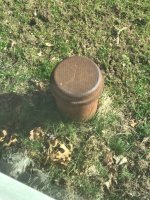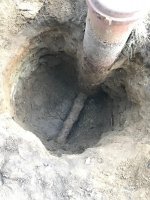SebMA
New Member
Hello, everyone. I read many pages so far this evening and would like to begin with some questions for guidance please. I have lived at my home for 3 years and I was told that there is a gravel well on my property. I have begun doing research this year to hopefully use the well to irrigate my lawn. I will tell you a bit about my property and the well casing and setup and hope you can advise me of next steps. Thank you.
1. The casing is cast iron and I was told comes in 20' runs. My particular well-point sticks out of the ground about 16" and has a threaded cap on it. I'll post a photo. I dug a hole on the side of the well that points to my foundation because the pro said it would be necessary. It exposed a pipe about four feet and 6"' down which would seem to be just lower than the water line I discovered. There, what seems to be a 2.5" splits from the well casing and goes straight into the house where it is abandoned and just sits flush into the foundation. The remainder of the pipe was rotted and remains on the floor.
Now that I think of it I don't really understand why he would need access to this pipe...
2. There is water when I measure 4.5' down from the cap of the well.
3. There is an obstruction at about 11' down where my tape stops when I try to stick something down. The professional also noted the same obstruction and thinks it's metal (perhaps old pump). But does not know. I commented to pump what was atop and hopefully see what it was - but he said that's not how he would do it.
At this point, I am confused as to what to do. I may go out and rent a pump, but if I know I'm going to need a pump of some kind I rather buy the one I need so I'm not wasting money for just a yield test. And I understand how dumb that sounds, but I was told this well serviced the home for 50 years up to the 1990's and so I feel confident it will produce especially since it's full with water as I opened the cap...any advice would be much appreciated. But I suppose my main question is open for ANY advice, but also - should I buy a shallow well submersible pump or a shallow well jet pump? and if it's not a submersible pump, where does it go? in the basement?
Thanks again and I'm happy to be part of this community.
1. The casing is cast iron and I was told comes in 20' runs. My particular well-point sticks out of the ground about 16" and has a threaded cap on it. I'll post a photo. I dug a hole on the side of the well that points to my foundation because the pro said it would be necessary. It exposed a pipe about four feet and 6"' down which would seem to be just lower than the water line I discovered. There, what seems to be a 2.5" splits from the well casing and goes straight into the house where it is abandoned and just sits flush into the foundation. The remainder of the pipe was rotted and remains on the floor.
Now that I think of it I don't really understand why he would need access to this pipe...
2. There is water when I measure 4.5' down from the cap of the well.
3. There is an obstruction at about 11' down where my tape stops when I try to stick something down. The professional also noted the same obstruction and thinks it's metal (perhaps old pump). But does not know. I commented to pump what was atop and hopefully see what it was - but he said that's not how he would do it.
At this point, I am confused as to what to do. I may go out and rent a pump, but if I know I'm going to need a pump of some kind I rather buy the one I need so I'm not wasting money for just a yield test. And I understand how dumb that sounds, but I was told this well serviced the home for 50 years up to the 1990's and so I feel confident it will produce especially since it's full with water as I opened the cap...any advice would be much appreciated. But I suppose my main question is open for ANY advice, but also - should I buy a shallow well submersible pump or a shallow well jet pump? and if it's not a submersible pump, where does it go? in the basement?
Thanks again and I'm happy to be part of this community.


